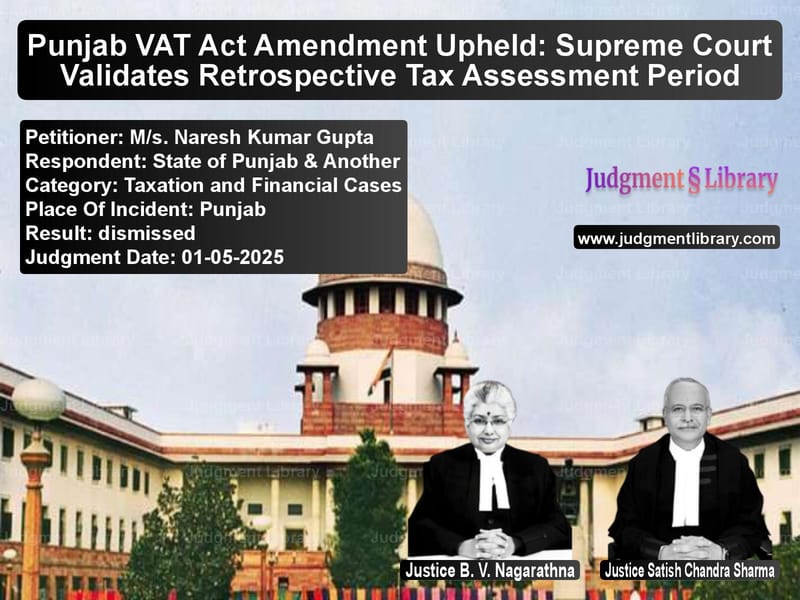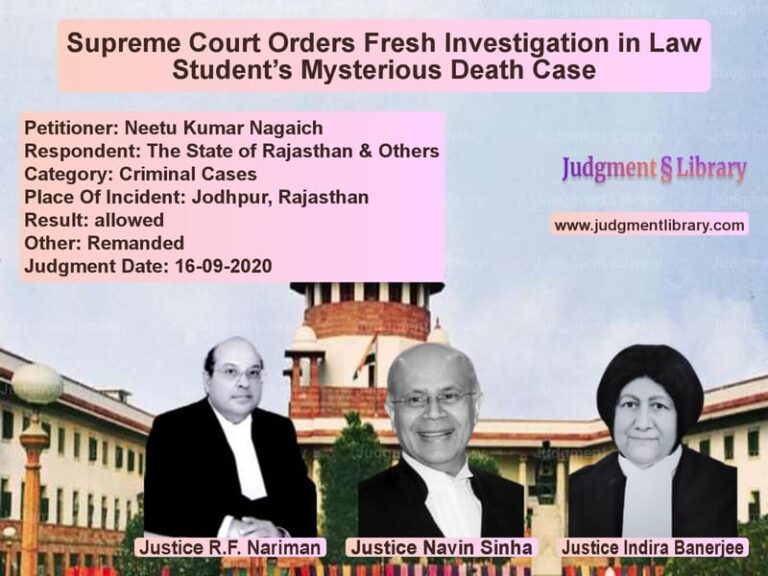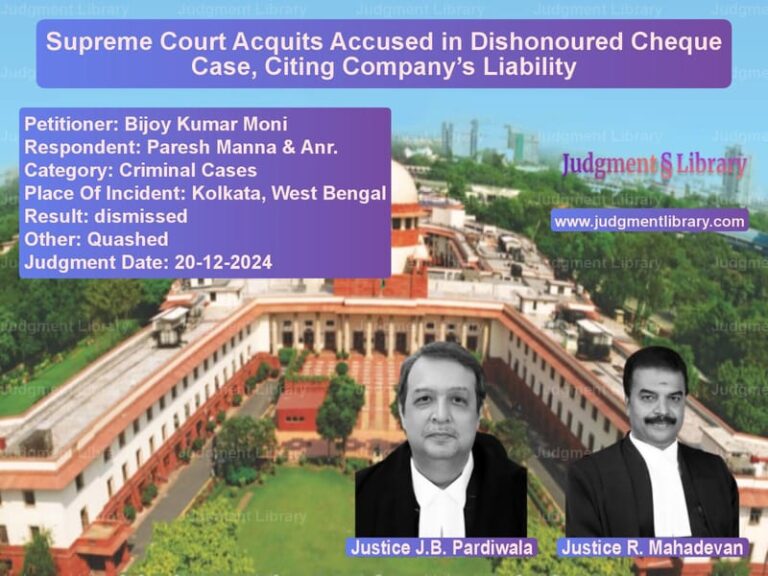Punjab VAT Act Amendment Upheld: Supreme Court Validates Retrospective Tax Assessment Period
In a landmark judgment that addresses the contentious issue of retrospective tax legislation, the Supreme Court of India delivered a comprehensive ruling on May 1, 2025, upholding the constitutional validity of amendments to the Punjab Value Added Tax Act, 2005. The case involved multiple appeals and transferred cases concerning the amendment to Section 29 of the PVAT Act by the Punjab Value Added Tax Act, 2013, which extended the limitation period for tax assessments from three years to six years and included retrospective application provisions.
The legal battle centered around amendments that fundamentally changed the tax assessment framework in Punjab. Under the original Section 29(4) of the PVAT Act, assessments could be made within three years after the annual statement was filed or due to be filed, with a proviso allowing the Commissioner to extend this period to six years under certain circumstances. The 2013 amendment replaced this with a straightforward six-year limitation period and included crucial explanatory provisions and a non-obstante clause that validated previous Commissioner orders extending the limitation period.
The appellants, comprising various businesses and taxpayers including M/s. Naresh Kumar Gupta, challenged these amendments on multiple constitutional grounds. They argued that the amendments were prospective in nature and could not apply retrospectively, that they effectively reversed several judgments of the High Court, that Explanation (2) violated principles of natural justice by retrospectively validating orders passed without notice, and that the provisions violated Articles 14 and 19 of the Constitution. Additionally, they contended that the amendments improperly extended the assessment period even where the original limitation period had already expired.
The Legislative Intent Behind the Amendments
The Supreme Court carefully examined the Statement of Objects and Reasons behind the 2013 amendments, which provided crucial insight into the legislature’s intent. The government explained that “Due to the provision of self-assessment in Punjab Value Added Tax Act, 2005, cases are selected by the Departmental Officers for the assessment on the basis of certain risk parameters or in which revenue is involved.” The statement highlighted two key problems: “due to heavy work load and shortage of staff in the Department, by the time the Designated Officer detects a tax due in a particular case, the limitation period of 3 years is near to end” and that “The Hon’ble High Court and the Hon’ble VAT Tribunal have quashed many such extension orders on technical ground of no prior service of notice to the concerned person before passing an order of such extension of limitation period and not passing individual orders, resulting in a huge revenue loss.”
The legislative intent was clear: to safeguard state revenue that was being lost due to technical grounds and operational constraints in completing assessments within the original three-year timeframe.
The High Court’s Reasoning
The Supreme Court noted that the Punjab and Haryana High Court, in its impugned judgment dated August 7, 2015, in the Amrit Banaspati case, had thoroughly examined the constitutional challenges and found the amendments valid. The High Court had observed that “the amendment cannot by any stretch of imagination be held to be so unreasonable or excessive as to warrant it being declared invalid.” It emphasized the established principle that “the proceedings which have attained finality under the existing law due to a bar of limitation cannot be held to be open for revival unless the amended provision is clearly given a retrospective operation so as to allow unsettling of proceedings, which had already been concluded and attained finality.”
The High Court had further held that “the legislature giving its own meaning or interpretation to a provision through a legislative fiat does not encroach upon the Courts’ domain to interpret the laws enacted by it.” This recognition of legislative competence to clarify or amend laws retrospectively formed a crucial part of the legal foundation for upholding the amendments.
Supreme Court’s Analysis and Findings
The Supreme Court, in its judgment delivered by Justice B.V. Nagarathna with Justice Satish Chandra Sharma concurring, conducted a comprehensive analysis of the constitutional issues raised. The Court found no reason to interfere with the High Court’s well-reasoned judgment upholding the amendments.
On the critical question of whether the legislature could extend the assessment period even after the original limitation period had expired, the Court relied on its previous decision in Additional Commissioner (Legal) & Another v. Jyoti Traders & Another (1999). In that case, the Court had upheld a similar amendment that extended the limitation period from four years to eight years, even though the original four-year period had expired before the amendment came into force. This precedent provided strong support for the validity of the Punjab amendments.
The Court emphasized that “the legislature has simply removed the basis on which those judgments were rendered and that the legislature was well within its powers to do so.” This recognition of legislative authority to amend laws to overcome judicial interpretations that hampered revenue collection formed a central pillar of the Court’s reasoning.
Practical Implications and Relief Measures
While upholding the constitutional validity of the amendments, the Supreme Court demonstrated judicial pragmatism by providing certain relief measures to the affected taxpayers. The Court “reserved liberty to the appellant/assessee(s) to avail the appellate remedy if so advised within a period of three months from today.” Importantly, the Court directed that “If such an appellate remedy is availed by the appellants herein, the State as well as the Appellate Authorities shall not raise the issue of limitation.”
In a significant relief to taxpayers in cases involving the State of Punjab and Union Territory of Chandigarh, the Court limited the financial burden by directing that “The said payment shall be restricted only to the principal amount of tax dues and shall not include interest and penalty therein.” The Court gave taxpayers until June 30, 2025, to pay the outstanding principal tax amounts.
Jurisdictional Limitations and Future Implications
In a crucial clarification with far-reaching implications, the Supreme Court restricted the application of its earlier judgment in State of Punjab vs. Nokia India Put. Ltd. (2014). The Court explicitly stated that “since the judgment of this Court in Nokia is now being restricted to the Act applicable in State of Punjab and the Act applicable in the Union of Territory of Chandigarh, the said judgment may not be a binding precedent insofar as other States’ enactments are concerned.”
This limitation opened the door for taxpayers in other states to challenge similar provisions in their respective state laws. The Court specifically “reserved liberty to any aggrieved party to contend that the judgment of this Court in Nokia is not applicable and therefore could be distinguished” when dealing with different state legislations.
Disposition of Cases from Different States
The Supreme Court adopted a nuanced approach in dealing with cases originating from different states. For matters arising from Andhra Pradesh, the Court recognized that the legal provisions might be distinguishable from those in Punjab. Consequently, the Court “re-transferred and restored on the file of the High Court” the cases from Andhra Pradesh for fresh consideration, giving parties the liberty to argue that the Nokia judgment might not apply to their cases.
The Court also directed the Andhra Pradesh High Court to expedite the hearing of these restored cases, acknowledging the long pendency of these matters. The Court specifically instructed that “the issue of limitation shall not be raised by the appellate authority or by the respondent-State” if parties choose to avail appellate remedies.
Broader Constitutional Principles
This judgment reaffirms several important constitutional principles regarding legislative competence in taxation matters. It recognizes that legislatures have the power to enact tax laws with retrospective effect, particularly when the intent is to clarify legislative purpose or overcome technical interpretations that frustrate revenue collection.
The judgment also underscores the balance between revenue interests and taxpayer rights. While upholding the state’s power to secure its revenue, the Court ensured that taxpayers received reasonable relief through the exclusion of interest and penalties and the opportunity to pursue appellate remedies without limitation barriers.
Furthermore, the Court’s careful limitation of the Nokia judgment’s precedential value demonstrates judicial awareness of the federal structure of Indian taxation, where each state’s legislation must be interpreted based on its specific language and context.
Impact on Tax Administration and Litigation
This ruling has significant implications for tax administration across India. It empowers state legislatures to design limitation periods that account for administrative realities while providing safeguards against revenue loss due to technical interpretations. However, it also serves as a reminder that such powers must be exercised reasonably and with due regard for taxpayer interests.
For ongoing and future tax litigation, the judgment provides clarity on the validity of retrospective amendments to limitation periods while opening avenues for challenging the application of precedents across different state legislations. The Court’s pragmatic approach in providing relief measures while upholding constitutional principles sets a balanced precedent for handling similar conflicts between revenue imperatives and taxpayer rights.
The Supreme Court’s comprehensive handling of this complex web of constitutional, procedural, and substantive tax issues demonstrates the judiciary’s role in balancing competing interests while respecting legislative authority in fiscal matters. The judgment provides much-needed certainty on the validity of retrospective tax legislation while ensuring that affected taxpayers receive fair treatment in the implementation of such laws.
Petitioner Name: M/s. Naresh Kumar Gupta.Respondent Name: State of Punjab & Another.Judgment By: Justice B. V. Nagarathna, Justice Satish Chandra Sharma.Place Of Incident: Punjab.Judgment Date: 01-05-2025.Result: dismissed.
Don’t miss out on the full details! Download the complete judgment in PDF format below and gain valuable insights instantly!
Download Judgment: ms.-naresh-kumar-gu-vs-state-of-punjab-&-an-supreme-court-of-india-judgment-dated-01-05-2025.pdf
Directly Download Judgment: Directly download this Judgment
See all petitions in Income Tax Disputes
See all petitions in GST Law
See all petitions in Tax Evasion Cases
See all petitions in Tax Refund Disputes
See all petitions in Customs and Excise
See all petitions in Judgment by B.V. Nagarathna
See all petitions in Judgment by Satish Chandra Sharma
See all petitions in dismissed
See all petitions in supreme court of India judgments May 2025
See all petitions in 2025 judgments
See all posts in Taxation and Financial Cases Category
See all allowed petitions in Taxation and Financial Cases Category
See all Dismissed petitions in Taxation and Financial Cases Category
See all partially allowed petitions in Taxation and Financial Cases Category







